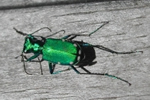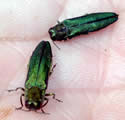DACF Home → Bureaus & Programs → Maine Forest Service → About Us → Forest Health & Monitoring → Invasive Threats to Maine's Forests and Tree → Purple Traps
Purple Traps and the Emerald Ash Borer
 Emerald ash borer (EAB) is a serious invasive pest of ash trees (Fraxinus sp.). This insect is native to Asia and attacks all species of ash in North America. Our native ash species have no defenses against the EAB and most die within a few years of attack. Emerald ash borer was first found in Michigan in 2002, and since then has spread rapidly throughout the eastern part of the continent (map). Although EAB can spread up to several miles a year on its own, much of the spread can be linked to the movement of infested firewood. Emerald ash borer is now one of the most devastating forest pests in North American history and has killed untold millions of ash trees since its introduction just decades ago.
Emerald ash borer (EAB) is a serious invasive pest of ash trees (Fraxinus sp.). This insect is native to Asia and attacks all species of ash in North America. Our native ash species have no defenses against the EAB and most die within a few years of attack. Emerald ash borer was first found in Michigan in 2002, and since then has spread rapidly throughout the eastern part of the continent (map). Although EAB can spread up to several miles a year on its own, much of the spread can be linked to the movement of infested firewood. Emerald ash borer is now one of the most devastating forest pests in North American history and has killed untold millions of ash trees since its introduction just decades ago.
Traps are one tool used to look for EAB in Maine. Other methods for looking for EAB, such as creating trap trees and using biosurveillance, are also very effective techniques, but traps are most efficient for a widespread detection effort.
Traps for EAB come in a variety of colors and shapes, but the most commonly used trap in Maine is the purple prism trap provided through cooperation with USDA APHIS. Maine has been participating in a national purple trap survey program since 2007. Each year, the Maine Forest Service Insect & Disease lab staff deploy 200 purple prism traps statewide in areas not yet regulated for emerald ash borer as an early detection tool.
The best tool for invasive insect detection is public awareness. Please learn more about EAB, and keep your eyes open for signs of its presence. If you think you've found it, please let us know.
A Year in Maine’s Purple Trap Survey in Maine:
January - April: The approach to the survey for the coming spring is planned. Supplies are ordered to arrive ahead of the need.
Emerald ash borer would be found beneath the bark this time of year. Cold winter temperatures in Maine are not enough to control emerald ash borer. They are protected under the bark of the tree and are adapted to cold climates.
May - June: Traps are deployed before the start of the adult flight season.
Adult flight period can begin as soon as early June in southern Maine--as the adult leaves the host tree a characteristic "D" shaped exit hole is created. Many of the green beetles reported by people in early May are actually six-spotted tiger beetles (image below). They are beneficial and they prey on other insects, including many pest species.


July - August: Traps are checked for emerald ash borer and lures are replaced.
Emerald ash borer adult activity has usually peaked by mid-July but adults can still be active during this period and into early fall. Foraging activity by Cerceris fumipennis, a ground nesting wasp that preys on metallic wood boring beetles such as emerald ash borer, is apparent by mid-July and used for biosurveillance.
September - October: Traps are removed and checked one last time for emerald ash borer.
Adult beetle activity is largely over, but still possible. Larvae hatched from eggs deposited on the bark of ash trees area now creating characteristic S-shaped feeding galleries below the bark in trees’ phloem material.
November - December: Trapping efforts are replaced with visual survey during the winter months.
As EAB larvae overwinter beneath the bark, woodpecker damage becomes most apparent at this time of year and can be an important clue in locating new infestations of emerald ash borer.
For more information on emerald ash borer in Maine visit www.maine.gov/eab.